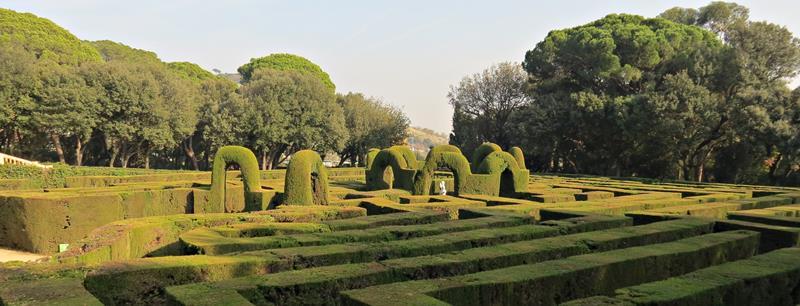
The Horta Labyrinth Park (Parque del Laberinto de Horta) is the oldest park preserved in Barcelona.. Not as well known as other parks in the city with a famous modernist architect or centrally located, but it is worth to visit it for its eccentricity and, as the name suggests, it has a maze or labyrinth.
The idea of eccentricity arises from the mixture of styles and the sum of elements: an aristocratic caprice is perceived and you can imagine the promoter of the project ordering the architects a design and construction of a temple or an additional pond to extend and increase the exclamations of admiration of the society of the time. And the labyrinth, an archetype in which children enter without thinking. Every town should have one. Mircea Eliade tells us: "The labyrinth is a magic defense of a center, a treasure, a meaning ... That symbolism is the model of human existence that faces numerous tests to advance to their own center, to himself, to the atman, as they say in India. Many times I have been aware when leaving a maze, having found his thread in the midst of adversity. We have all known that experience. But I must add that in life there is not only one maze. The test is repeated again and again ... "(" Ordeal by Labyrinth").

Don’t you think it is worth visiting it?
Something of its history
The Labyrinth Park is located in the district of Horta-Ginardó on a hillside in the Sierra de Collserola. Its construction, initiated by Joan Antoni Desvalls i d'Ardena sixth Marquis of Llupià and Marquis consort of Alfarrás, on land owned by him, began in 1794 and was finished in 1808. In the mid-nineteenth century, the heirs of the Marquis extended the park creating a romantic garden and adding new elements to the neoclassical garden. In the late nineteenth century and early twentieth century, the park was the scene of royal receptions (Carlos IV, Fernando VII and Alfonso XIII) and cultural evenings with performances of classical theater (in 1898 the play "Iphigenia in Tauris" by Goethe was performed, which was translated by Maragall and directed by Adrià Gual). In 1961 the family Desvalls gave the park to the City, who restored it twice (1971 and 1994 with EU funds) and it ended up being a garden-museum.
The labyrinth of this park is the type called maze coming from England in the twelfth century. Until then the labyrinths had only one way, you could not get lost. They were the classic labyrinths, as the Cretan or Roman. The labyrinths of mazes types, have confusing pathways with branches and the three phases of the path of a labyrinth: the entrance , the center and the exit , all important from a symbolic point of view.

Buildings and park elements
- The Palace of the Desvalls family with elements of neo-Arab and neo-Gothic style. In the palace grounds there is a heraldic fountain, a garden and the Torre Subirana, a medieval defense tower of the seventh century.
- The park, which has a total area of 9.1 ha, has a lot of sculptures (some with motifs from Greek mythology and others with rustic motifs), fountains and ponds.
- The hedge maze, which consists of 750 meters of trimmed cypresses, with an area of 45 x 50 meters.
- The Moss Garden with a grotto with a jet of water which has the form of a head of Minotaur.
- El Mirador, with two temples built in an Italian style with statues of Danae and Artemis, and Tuscan columns.
- The Pavilion of Charles IV, neoclassical, topped by a sculpture of Apollo and the Muses.
- A large pond fed by the source of the nymph Egeria inspired in the grotto by Stowe.
- A romantic garden with flower beds, large trees, a waterfall and a false medieval cemetery (no longer existing).
- The landscape park area is surrounded by a large Mediterranean woods.
The labyrinth is a magic defense of a center, a treasure, a meaning ... That symbolism is the model of human existence that faces numerous tests to advance to their own center, to himself, to the atman, as they say in India…" (Mircea Eliade)

How to get there?
The Labyrinth Park is located at Germans Desvalls street, 21. The best option by public transport is the metro: Line L3 direction Trinitat Nova to Mundet station. The park is 750 meters from the station. About half of the walk is a walk up the slope.
Closest parking: Parking BSM Sant Genís-Vall d'Hebron
Comments
Travelling from airport
Hi,
What is the best bus to get from the airport to carrier compte d' Urgell
Thank you
Compte d'Urgell
Hi Vimo,
You should leave your comment in the page of the airport.
¡Saludos!
In reply to Travelling from airport by Vimo (not verified)
Add new comment